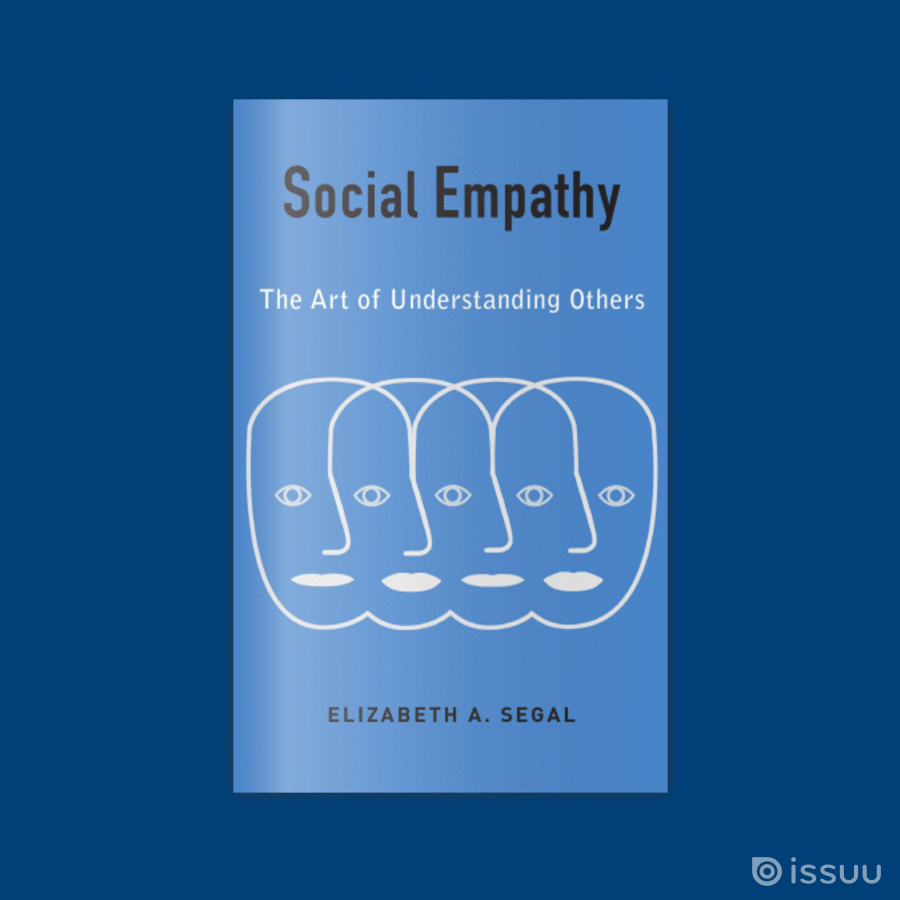How Empathy Can Help Us Become More Compassionate

“Social Empathy expands on what we know about interpersonal empathy and strikes right at the heart of today’s partisan conflicts. In readable, humane, and informative prose, this book explains how we can overcome tribal instincts and forge the supportive, meaningful connections we need in order to thrive in today’s global environment.”
~Caroline Wellbery, Georgetown University School of Medicine
In today’s political and social climate, the call for more compassion and empathy is strong, but do we know what either actually is? Elizabeth Segal, author of Social Empathy: The Art of Understanding Others, discusses these concepts in depth. She distinguishes between the two and considers how one, empathy, can lead to the second, compassion.
• • • • • •
More and more we hear a growing call for compassion and empathy. Politicians, celebrities, news commentators, and people in general bring up the need for more compassion and empathy in our public arena and daily lives. I could not agree more. However, often compassion and empathy are considered the same thing. They are not. Both are important, but different. Compassion, according to the Oxford Dictionary is “pity inclining one to help or be merciful.” The word’s origin is to “suffer together.” We tend to broaden the meaning of compassion in our day to day use to include sharing kindness and caring for others. Scholars who study compassion consider it “the concern we feel for another being’s welfare.”¹ Thus, we tend to see compassion as a positive emotion, one that we call on to move people to action based on a sense of the pain of others.
Empathy involves feelings for others too. But it is neither positive nor negative. It is the act of sharing and understanding the feelings of others. Think of it as “walking in another’s shoes,” seeing and feeling what the world looks like through and from the eyes of another. So how is this different from compassion, and does it matter?
“Compassion and empathy are considered the same thing. They are not. Both are important, but different.”
Empathy starts with sharing the emotions and feelings of another person, often unconsciously. Physical sharing can lead to thinking about what those feelings mean for the other person. For example, suppose you come into work and hear someone crying. The mirroring reaction we have automatically will trigger your own physical sensation to feel like crying. Immediately you will begin the cognitive process of wondering who it is and what it is about. The crying could be due to sadness or may even be tears of joy. Maybe your co-worker just received a big promotion. Figuring out what exactly those emotions mean requires gathering more information. In the language of empathy research, we call that first step unconscious affective response, followed by more conscious cognitive perspective-taking. To engage fully in empathy requires two additional skills – the ability to understand that the feelings you are having are a mirror of the other person’s, not your own, and that you can do this while maintaining your own emotions. This is a lot to do in a matter of seconds. Although we have the basic tools as human beings, it takes learning and practice to fully engage in empathy.
Empathy can lead us to understand what it is like for another person to suffer, as in the official definition of compassion. Empathy can also help us share another person’s fear, anger, joy, surprise, happiness, and other emotions, and understand what those emotions mean to them. It is broader than compassion. As the famous primatologist Frans de Waal noted, empathy is the glue that binds us together as human beings.² If we can deeply understand others, we will be more likely to care about their well-being, which is the broader definition of compassion.
“Empathy can lead us to understand what it is like for another person to suffer, as in the official definition of compassion. Empathy can also help us share another person’s fear, anger, joy, surprise, happiness, and other emotions, and understand what those emotions mean to them.”
My new book, Social Empathy: The Art of Understanding Others, discusses how empathy allows us to fully engage in understanding the circumstances of other people’s lives. For example, like for most city dwellers, on my way to and from work I often pass people who are homeless and asking for help. I know this because their hand-held signs or statements tell me that they are homeless. Their stories —being a veteran or having an illness or losing their job—might move me to pity and feeling their suffering. In doing so, I might feel compassion, which can move me to drop some coins into their cups or hand them some dollar bills. But what about the deeper realities of their lives?
The broader experience of empathy can take us from the moment to the larger meaning of those moments. Why is a veteran or a sick person or a person without a job panhandling on the street corner? Is it because we do not have enough retraining services or mental health care for veterans after they leave the military? Do we live in a city where housing costs are high and low-income earners cannot afford to live there? Engaging more deeply in interpersonal and social empathy might move me to consider larger issues, such as how well do we provide benefits for our veterans or what housing costs. I might even need to engage in interpersonal empathy to feel sure that this is a person in need and not someone trying to get me to give away some money. With deeper perspective, I might choose to give away a few coins or dollars or not to, but I am more likely to consider that experience when I am teaching and sharing opinions with others or making decisions about support or opposition to public policies. We can consider how the collection of those moments matter to our lives, to others, to our communities, to our society. And we can use that deeper insight to show concern and compassion and make changes that improve people’s well-being. It may sound lofty and idealistic, that I am asking us to tilt at windmills, but empathy gets easier the more we do it.
“If we can go further and imagine what life is like for others, walk in their shoes, and do it with knowledge of the broader circumstances and history that may have faced that person as a member of another group or community, we will have fully engaged in empathy.”
The practice of empathy comes when we pay attention to our physical reactions to others and situations. When we ask ourselves why we are experiencing those shared feelings and what it might be like for the other person or group. And while we are doing this, we take care to remember that those feelings are not our own but our shared reaction to others. If we can go further and imagine what life is like for others, walk in their shoes, and do it with knowledge of the broader circumstances and history that may have faced that person as a member of another group or community, we will have fully engaged in empathy. Do I do that every time I pass a person who is homeless? No, some days I am too distracted by my own life to engage that deeply with others. However, by engaging in empathy as often as I can, I get greater insight each time. I remember to call on that image when I am teaching others, when I am working in my community, and when I am voting.
As you go through your daily routines, take time to pay attention when you might be reacting to others. Go ahead, share their feelings, try to understand what it is like to be in their situation. How might you feel if you were that other person? It’s not your own feelings, but theirs as you are sharing them. Keep in mind our differences and how belonging to other groups or communities shape people. If you can, think about what circumstances may have contributed to their situations in life. Go deeper to understand who they are and where they are coming from. It may not be easy, and it won’t happen with every encounter you have, but doing it when you can will build your foundation for empathy.
1 Keltner, D., Marsh, J., & Smith, J.A. (Eds.) (2010). The compassionate instinct. New York: W.W. Norton & Company, (p. 8).
2 de Waal, F. (2009). The age of empathy: Nature’s lessons for a kinder society. New York: Crown Publishing Group.
3 Segal, E.A. (2018). Social empathy: The art of understanding others. New York: Columbia University Press.
Save 30% on this or any of our books when you order from our website by using coupon code: CUP30 at checkout!






